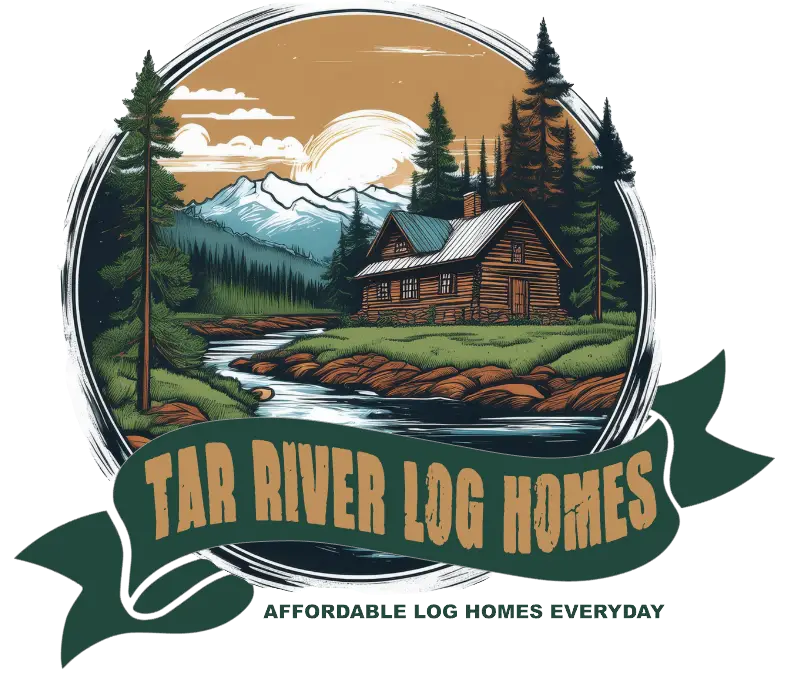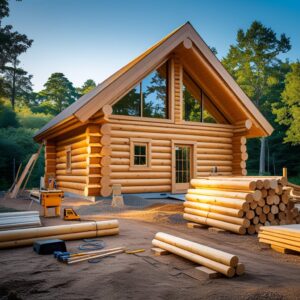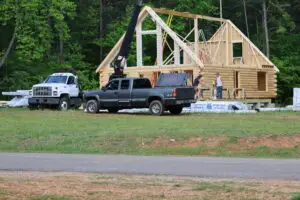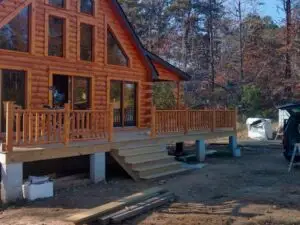Building a log home is a big project, but it doesn’t have to be overwhelming. Custom log home kits make it easier by bundling the essential materials into one package.
With these kits, you can shape the design to fit your lifestyle and budget. From the floor plan to the log style, you stay in control of how your cabin looks and functions.
At Tar River Log Homes, we believe families deserve clear pricing and strong materials without surprise markups. By working directly, we keep costs fair so you get the most value for your money.
The best part? Custom log home kits give you flexibility. You decide what matters most, so you build matches your needs instead of the other way around.
This guide walks through what custom log home kits include, how to choose the right one, and what to expect from design to delivery.
What Are Custom Log Home Kits?
Custom log home kits include almost everything you’ll need to build your own log house. You pick the design, the kind of logs, and the layout. These kits come in different styles, sizes, and finishes to match your taste and budget.
You get to control the look while keeping costs upfront and materials solid. It helps to know what kinds of kits are out there and why making it your own really matters.
Definition and Overview
A custom log home kit is basically a package of all the core materials for building a log home. Usually, you get pre-cut logs, windows, doors, and detailed blueprints. The logs come ready to assemble, which makes the building process faster and, honestly, less stressful.
You decide on the style, size, and details that fit you and your land. Once you’re ready, the kit shows up at your site, and you (or your builder) can jump right into construction. Since everything’s planned and packed up front, there’s less chance you’ll run into surprise costs or missing pieces.
Types of Log Home Kits
There are a few main types of log home kits, depending on how much is pre-made:
- Shell kits: These include the basics—walls, roof, floor systems—but leave the inside unfinished.
- Shell and interior kits: Add in interior walls, stairs, and windows.
- Complete kits: Pretty much everything, even plumbing, wiring, and fixtures.
Some kits use Eastern White Pine logs (tough and reliable), while others offer different woods or log shapes—round, square, or even handcrafted. Pick what matches your skills, style, and budget.
Benefits of Customization
Custom kits let you make your log home your own. You decide the floor plan, log size, window layout, and extras like decks or porches. This way, your home matches your family and your lifestyle.
Customizing also means you can stick to a budget. Maybe you go a little smaller, or splurge on better windows. Plus, smart design choices can make your home more energy efficient.
Some suppliers specialize in custom options, focusing on solid materials at fair prices. The right partner helps you build with confidence.
Designing Your Custom Log Home Kit
With a log home kit, you get to shape how your cabin looks and feels. That means picking a design style, tweaking the floor plan to suit your life, and choosing the log type for your walls. Each choice makes the home feel more like you.
Popular Design Styles
Log homes come in a handful of styles, each with its own vibe. The Rustic style uses rough, natural logs and roomy porches—classic cabin stuff.
The Contemporary style has smoother logs and big windows for a lighter, more modern feel. It works great with open floor plans and lots of daylight.
There’s also the Traditional style, which mixes old-school charm with modern comfort. You’ll see simpler lines and cozy layouts in this category.
Start with the style you like best—it’ll help guide the rest of your choices.
Personalizing Floor Plans
Your floor plan should actually fit your life. Think about how many bedrooms and bathrooms you need. Want an open living room? Or maybe some separate spaces for work or hobbies?
You can tweak room sizes or add features like a loft, wrap-around porch, or a garage. Many kits include base plans you can adjust to your family’s needs. You can pick a plan or share your ideas for a custom one. That way, you get exactly what you want—no paying extra for stuff you’ll never use.
Selecting Log Profiles
Log profiles are just the shapes and cuts of the logs. They change both the look and how the build goes.
Some common profiles:
- D-shaped logs: Flat on one side for a snug fit and easier finishing.
- Round logs: The classic log cabin look, full diameter inside and out.
- Square logs: Smooth and uniform, great for a modern look.
You’ll also pick your wood. Eastern White Pine is a top choice—strong, lightweight, and good for insulation. Your pick affects the price, style, and how much work goes into upkeep. Some providers offer logs that are cut and dried to make things easier and keep costs down.
Choosing a Log Home Kit Provider in the USA
Picking a kit provider isn’t just about price. You want solid materials, good support, and a company that works with local builders to match your style and budget.
Key Selection Criteria
Look for a provider with clear pricing—no sneaky fees. You want strong, kiln-dried logs that can handle your climate. Check if they offer custom log home plans so you can build what fits you.
Customer support makes a big difference. Can you actually get someone on the phone? Do they answer questions without jargon? That saves you headaches later. Some providers even offer a price guarantee, which adds peace of mind.
Top-Rated American Manufacturers
Stick with U.S. companies that cut and dry logs themselves. That keeps quality up and costs down. Brands using Eastern White Pine logs are a favorite—this wood holds up well in most climates.
A lot of these teams use a straightforward process and walk you through each step. That saves time and cuts down on confusion. Go for a provider that ships kits right to your site—no weird extra charges or delays.
Look for a provider that skips the corporate extras and focuses on quality.
Working With Local Builders
Even the best kit needs a builder who knows what they’re doing. Find local contractors with log home experience. They’ll help you customize and handle the quirks of log construction.
Ask your provider if they know any trusted builders nearby. Teaming up with the right pro can save money and speed up your build. A good builder makes a big difference in getting the home you actually want, at the price you expect.
Materials and Construction Techniques
Your wood choice and construction style really shape how your log home looks, lasts, and costs. You’ll want to know what wood fits your style, how logs go together, and if the materials are responsibly sourced. These details matter for both your wallet and peace of mind.
Wood Species Available
Picking the right wood type is key. Eastern White Pine is a go-to—it’s strong, easy to work with, and looks great. Cedar’s another option; it naturally fights off bugs and rot, though it’ll cost you more. Douglas Fir and Spruce are also used for their strength and nice grain.
Each wood has its own look and feel. Eastern White Pine is light with subtle knots, giving a clean, bright look. Cedar is deeper in color and even smells good. Kiln-dried Eastern White Pine logs help your home stay tight and stable.
Construction Methods
Logs get joined in a few main ways:
- Saddle Notch: Logs lock together with notches—classic and sturdy.
- Chinkless: Logs are milled flat for a snug fit, so you skip the chinking step.
- Dovetail: Angled cuts lock logs at the corners, making them really secure and weatherproof.
How you join the logs affects sealing, energy use, and the look. With custom kits, you pick what fits your skills and style.
Sustainability and Sourcing
Where your wood comes from matters for the planet and your home’s quality. You want logs from forests that are managed right, so you’re not part of the over-cutting problem. Responsible sourcing from U.S. forests supports both durability and sustainability.
Kiln-dried logs cut down on waste and boost durability. Buying wood close to home means lower shipping costs and less pollution. A supplier who’s open about their sourcing lets you make a choice you can feel good about.
Pricing and Budgeting for Custom Kits
Building a log home means watching your budget and knowing what drives the cost. It helps to see what changes prices and what payment options you have.
Factors Affecting Cost
The size of your log home kit is the biggest factor. Bigger homes need more logs and materials, so the price goes up. The wood type matters too—Eastern White Pine, for example, gives you quality without sky-high prices.
Customization adds to the bill. Want a special floor plan, more windows, or unique finishes? Expect to pay more. Delivery distance also affects shipping fees—the farther you are, the higher the cost.
Don’t forget site prep and the foundation. Those aren’t part of the kit price but can be a big chunk of your budget, depending on your land and local labor.
Financing Options
Paying for a custom log home kit can go a few ways. Most builders, like Tar River Log Homes, ask for a deposit to get started. After that, you’ll usually pay in steps: deposit, blueprint fee, premanufacture payment, and the final payment when your kit’s ready.
You might use your savings, a home equity loan, or a construction loan. Each has its own pros and cons, depending on your credit and how fast you want to build.
Some folks order a basic kit first, then add upgrades as they go. It’s wise to plan your payments so you’re not stretched too thin during the build.
Delivery and Assembly Process
Getting your kit shipped and assembled is a big part of the whole adventure. You’ll want to know how delivery works across the USA and whether you should build it yourself or hire someone.
Shipping Logistics in the USA
Most suppliers ship kits as one big package right to your property. Usually, it comes on a flatbed truck, though sometimes on a freight truck, depending on where you live.
Delivery times vary. Most spots in the lower 48 states get their kit in 2 to 6 weeks after final payment. If you’re in a remote area or on an island, it’ll probably take longer.
You’ll get details about delivery dates and what to expect. Make sure there’s space to unload and, ideally, have a forklift or crane handy.
DIY vs. Professional Assembly
You can build your log home kit yourself if you’re handy and have the right tools. The kits include detailed plans and labeled parts, so you’re not left guessing.
Doing it yourself saves money but takes time and effort. If you want a hands-on project and have some help, go for it.
Hiring pros costs more but speeds things up and gives you a polished result. Many contractors know log homes inside and out, so they can handle tricky stuff like sealing and roofing.
Maintenance and Longevity
Looking after your log home keeps it strong and looking good. A bit of regular care helps prevent damage and makes your home last longer. Here’s what you’ll need to pay attention to.
Caring for Your Log Home
Give your log home a check at least once a year. Watch for cracks, loose logs, or any signs of moisture. Cleaning off dirt and debris helps keep rot at bay.
Apply a good stain or sealant every few years—usually every 3-5 years. That keeps water and sun from beating up the wood. Just be sure the product matches your log type.
Keep gutters clean and make sure water drains away from your foundation. Good drainage is key—water pooling around your home is just asking for trouble. These small chores might seem boring, but they really pay off.
Common Issues and Solutions
Logs crack or shrink as time goes by—nothing unusual there. Most small cracks just close up as the wood settles in. If you notice any cracks getting too wide, though, grab some outdoor log caulk and seal them up before they become a problem.
Pests like termites or carpenter ants can sneak in. You might spot little sawdust piles or tiny holes in the wood. If you do, treat the area with a product made for log homes, or honestly, sometimes it’s better to just call a pro and let them handle it.
Mold and mildew love damp spots, so keep an eye out. Clean these areas with water and mild soap; skip the harsh chemicals—they’re rough on your logs. Durable materials and clear guidance make it easier to care for your log home.
Lifestyle Benefits of Log Home Living
A log home isn’t just a house—it comes with perks like lower energy bills and a healthier living space. You get that warm, natural vibe that fits just about any climate and feels good to live in.
Energy Efficiency
Thick, solid wood walls act as built-in insulation. They keep things warmer in winter and cooler in summer, so you don’t have to crank the heat or AC all the time. Wood logs soak up heat during the day and let it out slowly, so your home’s temperature doesn’t swing wildly.
That means you’re saving on energy bills and staying comfortable, which is honestly pretty great. Add in some energy-efficient windows and doors, and you’ll boost insulation even more. Quality materials help keep energy waste down and comfort up.
Boosting Energy Savings with Custom Kits
The design of your log home has a big effect on energy use. South-facing windows capture heat in winter, while roof overhangs block summer sun. Thicker logs store heat during the day and release it at night, cutting down on heating swings.
Adding insulation in floors and ceilings helps meet modern energy codes. Custom kits give you the flexibility to choose log thickness, window placement, and sealing methods that lower long-term energy bills.
Health and Wellness Advantages
Living in a log home often means breathing cleaner air. Wood helps balance humidity, so your home won’t get too stuffy or too dry.
Logs slowly take in and let out moisture, which keeps your indoor air feeling fresh. That can help cut down on mold and dust mites—a big plus if you have allergies.
And, let’s be real, being surrounded by natural wood just feels good. Lots of people say it’s calming, and I have to agree—it’s a peaceful place to come home to.
Inspiration: Custom Log Home Kit Success Stories
Families across the USA have put together their dream log homes with kits that fit their needs. These projects show off how smart planning and quality materials can combine to make homes that are both beautiful and sturdy. Homeowners have shared their stories, offering a peek at what works and what to expect.
Featured USA Projects
A family in Tennessee decided to add a wrap-around porch and bigger windows to their kit. The instructions were clear, so putting it together wasn’t as tough as they’d feared. They liked the look and strength of the Eastern White Pine logs.
In Vermont, a couple picked a two-story log cabin plan for their wooded property. They did most of the build themselves, which saved money and let them create a cozy, solid home. Their kit included everything from walls to roofing, all shipped right to their land.
These stories show you can steer your design and budget by picking the right kit. The right materials help you save without skimping on quality.
Building Your Dream Cabin with a Custom Kit
Custom log home kits give you the freedom to design a cabin that truly fits your life. From choosing the floor plan to picking the right wood, you stay in control while keeping costs clear.
With smart planning and the right provider, these kits make building a log home less stressful and more affordable. The end result is a sturdy, comfortable cabin that feels like home from day one. At Tar River Log Homes, we keep things simple—fair prices, strong materials, and support that helps you build with confidence.
Ready to start planning your custom log home? Get in touch for quotes, and let’s make it happen.
Frequently Asked Questions
Buying a custom log home kit? You’ll have questions about price, size, and quality. It’s smart to look for honest reviews and know what to check before you buy.
What are the starting prices for custom log home kits in the USA?
Most basic kits start around $20,000. Bigger or more detailed kits can go for $50,000 or more, depending on what you want.
Where can I find reviews for the best custom log home kit providers?
Check out home building forums and log home websites for reviews. It’s also worth asking the company for customer references directly.
Are there any log home kits available for under $10,000?
It’s rare, but you might find a kit under $10,000 if you’re okay with a tiny or super simple design. Just know you’ll get basic plans and limited materials at that price.
Can you buy a small cabin kit for under $25,000?
Definitely. Plenty of companies offer small cabin kits under $25,000. Usually, these come with the structural logs and the basics to get your build started.
What should I consider when purchasing a log home kit for sale?
Look at what’s included, the quality of the logs, and whether you get blueprints. Don’t forget about shipping costs and whether you’ll need to buy extra supplies.
How do I choose the right company for a custom log home kit?
Start by checking if the company lays out their prices upfront—nobody likes surprise fees. Dig into their customer support; if you can actually get a real person on the phone, that’s a good sign. Reviews from actual homeowners matter more than glossy photos. Look for one that’s transparent on pricing and focused on quality materials.




